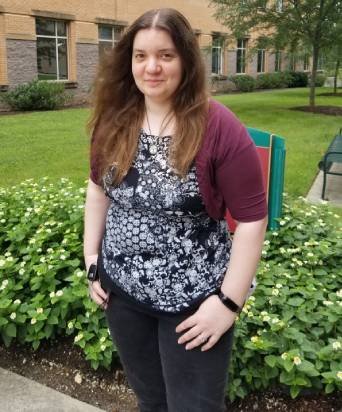
Computer science instructor Katherine “Raven” Russell is teaching CS 310: Data Structures, a programming course, on campus this fall. Students are very respectful of the physical distancing and mask requirements, she says.
Computer science instructor Katherine “Raven” Russell likes to debug complex code, so she volunteered to tackle a different type of challenge this fall by teaching an in-person programming course on campus.
Of the approximately 400 undergraduates taking CS 310: Data Structures, 54 of them are coming into a large lecture hall where they are required to follow the Safe Return to Campus guidelines. It’s the Department of Computer Science’s (CS) only class that is meeting on campus this semester.
“The in-person class feels a bit odd right now, but students are very respectful of the physical distancing and mask requirements,” says Russell, MS Computer Science ’12, who won a Teacher of Distinction Award in 2020 from the Stearns Center for Teaching and Learning. “I only had one person I had to remind to pull up his mask because he started chewing on his pencil and didn’t realize what he was doing.”
This course is important because it introduces a lot of computer science theory and polishes undergraduates’ programming skills for senior courses, she says. “It’s one of the foundational subject areas. Some students come in and are starting to feel confident, and we can reinforce that and shore up any problems they are having.”
Russell had to make several adjustments this semester. She has everyone submit their COVID-19 Health Check before coming to class, and she wears a mask while she’s teaching on the stage about 20 feet away from the nearest student.
She uses active-learning techniques in her large lecture classes--presenting a problem and having the students solve it. In a typical semester, they work with someone who is sitting near them, and there is a lot of chatter as they come up with different solutions, she says.
But this semester, students are quietly doing the problems on their own. After they are finished, she suggests they make eye contact with someone nearby and talk about their work. “These are just odd things that are part of this year,” Russell says.
Still, she says, several students have told her how much they appreciate being able to come to class. “Some know that it’s in their best learning interests to take the subject face to face.”
Russell says she’s still working on some of the challenges, such as how to chat with students while they work on problems and maintain social distancing at the same time. “But we’ll debug the teaching problems as we go.”
